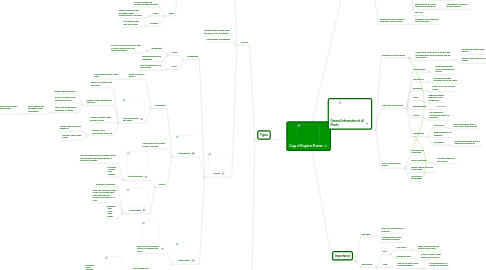
1. Types
1.1. Vascular
1.1.1. Non- seeded
1.1.1.1. Life cycle dominated by Sporophytes
1.1.1.2. Plant Structure
1.1.1.2.1. Phloem
1.1.1.2.2. Roots
1.1.1.2.3. Leaves
1.1.1.2.4. Xylem
1.1.2. Allowed plants to grow taller and gain access to sunlight
1.1.3. Independant Sporophytes
1.1.4. Seeded
1.1.4.1. Morphology
1.1.4.1.1. Ovule
1.1.4.1.2. Pollen
1.1.4.2. Angiosperms
1.1.4.2.1. Morphology
1.1.4.2.2. Seed plants that produce flowers and fruits
1.1.4.2.3. Groups
1.1.4.3. Gymnosperm
1.1.4.3.1. Seeds are not encased in ovaries, but exposed on cones
1.1.4.3.2. Groups
1.2. Non-Vascular
1.2.1. Life cycle is dominated by Gametophytes
1.2.1.1. Sporophytes rely on the gametophyte for survival
1.2.2. Non vascular means they do not have xylem or phylem tissues
1.2.2.1. Accounts for their small size
1.2.3. Water is required for fertilization
1.2.4. commonly called bryophytes
1.2.5. Examples of Organisms
1.2.5.1. Liverworts
1.2.5.2. Hornworts
1.2.5.3. Mosses
1.2.5.3.1. Closely related to vascular plants
1.2.6. Plant Structure
1.2.6.1. Gametophytes
1.2.6.1.1. Protonema
1.2.6.1.2. Gametophore
1.2.6.1.3. Rhizoids
1.2.6.2. Sporophytes
1.2.6.2.1. Capsule
1.2.6.2.2. Seta
1.2.6.2.3. Foot
1.2.6.2.4. Stomata
2. Origins
2.1. Green Algae (Charophytes)
2.1.1. Reasons for colonizing land
2.1.1.1. Few predators
2.1.1.2. Plentiful CO2
2.1.1.3. Unfiltered sun
2.1.2. Evidence
2.1.2.1. Both have Cellulose cell walls
2.1.2.2. Cell plates are produced the same way
2.1.2.3. Plants and Charophytes have Peroxisomes that contain the same enzyme, no other algae has
2.1.2.3.1. Peroxizome: an organelle found in plants that breaks down fatty acids and produces hydrogen peroxide
2.1.2.4. Sperm structures are closely related
2.1.3. Sporopollenin prevents zygote from drying out
2.1.3.1. Sporopollenin: a layer of durable polymer
2.1.4. 500 MYA
2.2. Symbiotic relation between fungi and first land plants
2.2.1. fungi gave plants (without roots) nutrients
3. General Information of all Plants
3.1. Alteration of Generations
3.1.1. 1 generation of the plant is Diploid, the next generation will be haploid, and the next Diploid
3.1.1.1. Haploid plants grow from spores
3.1.1.2. Diploid plants grow from a zygote
3.2. Important Terminology
3.2.1. Gametophyte
3.2.1.1. A haploid plant that produces gametes by Mitosis
3.2.2. Sporophyte
3.2.2.1. A diploid plant that produces spores by Miosis
3.2.3. Bryophyte
3.2.3.1. Refers to all non vascular plants
3.2.4. Ovule
3.2.4.1. Megasporangium, megaspore, and integument
3.2.5. Embreophytes
3.2.5.1. Land plants
3.2.6. Cuticle
3.2.6.1. The epidermes, consisting of wax and polyester
3.2.7. Gametangia
3.2.7.1. Antheridia
3.2.7.1.1. Male gametangia, where many sperm are produced
3.2.7.2. Where gametes are produced
3.2.7.3. Archegonia
3.2.7.3.1. Female gametangia where a single egg is produced
3.3. Four traits of all land plants
3.3.1. Alternation of Generation
3.3.2. Apical meristems
3.3.2.1. Localized regions of cell division
3.3.3. Walled Spores produced in sporangia
3.3.4. Multicellular gametangia
4. Importance
4.1. Ecological
4.1.1. helps the colonization of new land
4.1.2. Seeded plants are the dominant producers
4.2. Economical
4.2.1. Fuel
4.2.1.1. Fossil Fuels
4.2.1.1.1. Decay of Carboniferous forests became coal
4.2.1.2. Alternative Fuel
4.2.1.2.1. mosses decay to peat which can be burned
4.2.2. Food
4.2.2.1. Most of our food comes from angiosperms
4.2.2.1.1. 6 crops yield 80% of calories we consume
4.2.3. Wood
4.2.3.1. xylem tissue of seeded vascular plants
4.2.4. Medicine
4.2.4.1. Secondary compounds of seeded plants

